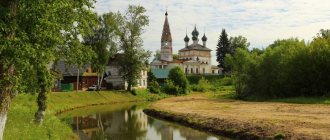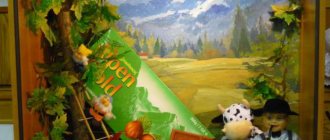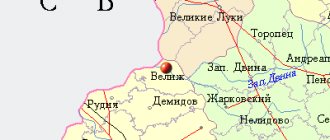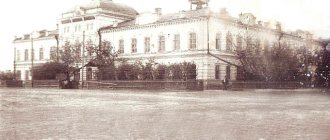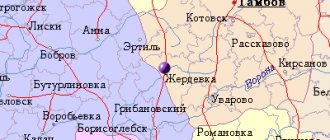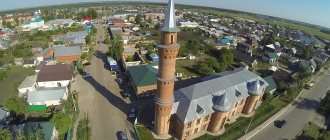Wedge
- a city of regional subordination in the Moscow region, the administrative center of the Klinsky district.
coat of arms
Population (2010) 80.6 thousand people. (1992 - 95.1 thousand, 1972 - 84 thousand, 1939 - 28 thousand, 1897 - 5.1 thousand). The city is located on the banks of the Sestra River, 65 km from the Moscow Ring Road along the Leningradskoe Highway (86 km). Railway station on the Moscow - St. Petersburg line. A narrow-gauge railway previously operated in the city and its environs, owned by. Within the city limits there is a military airfield Klin-5 ([1]), capable of receiving aircraft of almost all classes.
Locality: Klin city
- Name: Klin
- Status: city
- Number of inhabitants: 84,000
- Applies to: Urban settlement Klin
Geographical coordinates
- Latitude: 56.331621
- Longitude: 36.729151
- Klin (city) on the map
wedge
Story
The first mention dates back to 1317 - the Nikon Chronicle says: “... In the summer of 6825... Prince Yuri Danilovich of Moscow with Kavgady and with many Tatars and with the princes of Suzdal... went from Kostroma to Rostov, and from Rostov went to Pereyaslavl, and from Pereyaslavl went to Dmitrov, and from Dmitrov to Klin.” Was part of the Tver Principality. In 1408, Edigei was ravaged by the Tatars. In 1482 Klin was annexed to the Moscow Principality. In 1569 Klin suffered greatly from the oprichnina. In 1572, Ivan IV bequeathed to his son Ivan Klin with volosts, villages and duties; later Klin was the patrimony of the Romanov dynasty. In 1617, Sokolovsky's Poles besieged the city, where Pozharsky and Dmitry Petrovich Lopata held the defense. In the 18th century, a post office was established in Klin by decree of Peter I. From 1785 - a district town in the Moscow province; At the same time, Klin acquired a regular plan. In 1851, one of the first railways in Russia, Nikolaevskaya[2], passed through Klin. Workers of Klin factories actively participated in the strike movement of 1905. From November 23 to December 15, 1941 it was in the hands of the Nazi occupiers; suffered greatly. Restored according to a new master plan. The central parish of the Klin deanery is the Church of the Icon of the Mother of God “Joy of All Who Sorrow” (Church of Sorrows). The church operates a Sunday school, an Orthodox gymnasium and correspondence theological courses. Parishioners participate in the creation of Orthodox radio and television programs. The rector of the temple is Archpriest Boris Alekseevich Balashov. Patronal feast day - the icon of the Mother of God “Joy of All Who Sorrow” (November 6, New Art).
History of the city of Klin in the XIII-XVII centuries. In those turbulent times of civil strife, lands often passed from one owner to another, and by the middle of the 13th century, Klin became part of the Tver Principality. During the Tatar-Mongol invasions, Klin, like other Russian cities, was ruined more than once, and then Moscow and Tver fought for it. By the end of the 15th century, in 1482, the city became part of the Moscow Principality and very quickly lost its military-strategic significance, since there were more powerful fortified fortresses on the western borders of the principality. However, Klin did not fall into disrepair: the city became a center of trade and craft, and the main occupation of its residents became carriage and the Yamsk postal business. In 1702, Klin, by decree of Peter I, became an official “mail pit”. Residents of Klin began serving a fairly large number of travelers. A variety of trading shops, inns, wine cellars, food warehouses and other establishments appeared in the city. Thus, meeting the needs of travelers, the city gradually stretched along the highway. The city of Klin in the XVIII-XIX centuries. In 1781, Klin received the official status of a city and a coat of arms. And in 1784, a master plan for the development of the city was developed, according to which the House of Public Places, the Mayor’s House and an almshouse were located in the center. At the turn of the 18th-19th centuries, according to the design of the landowner-architect S.P. Karin, a postal yard was built - a two-story brick building and two one-story outbuildings. Sheds for horses, a well and a stable were built here. In 1851, the first branch of the Nikolaev Railway in Russia passed through Klin, which led to a decrease in Yamsk transportation. The meaning of “stand still” has also fallen. Now a significant part of the city's population began to engage in hand weaving and make scarves, muslin, and woolen upholstery fabrics for furniture. By the end of the 19th century, Klin had turned into a quiet, provincial town. Its center also shifted somewhat, now it was represented by Cathedral Square with stone shopping arcades, a hotel, a government office and a fire tower located on it.
Wedge
Ancient history
Traces of Slavic settlements in these territories date back to the middle of the first millennium AD, making Klin one of the oldest settlements in the region. Since ancient times, the Ilmen Slavs settled along water trade routes.
The wooden fortress, founded by Prince Yuri Vsevolodovich in the 13th century, was an outpost of the Vladimir-Suzdal principality in the Volga basin. The strategic position on a hill in a bend of the Sestra River (a tributary of the Dubna River) was ideal for defense. In the Finno-Ugric languages, the word “Sister” meant a river with blackcurrant banks. Perhaps the origin of the name of the city is connected precisely with the geographical location of the fortress, as if wedged into the river. The remains of the ancient Kremlin, surrounded by an earthen rampart and ditch, existed until the end of the 18th century.
There is no consensus among scientists on the question of the founding date of the city. The majority is inclined to 1317, based on the authoritative Nikon Chronicle. However, V.N. Tatishchev points in “Russian History” to sources dating back to 1190. Unfortunately, these originals were irretrievably lost during the Napoleonic Wars. The Trinity Chronicle of 1234 talks about a certain Klin, but historians are inclined to believe that it was a settlement of the same name.
Klin in the Middle Ages
In the middle of the 13th century, the Tver principality, and with it Klin, separated from the Vladimir lands. During this era, border fortresses were often subject to Mongol-Tatar raids, and in 1408, a horde led by Khan Edigei burned Klin on its way to Moscow. The restored fortress became the subject of a dispute between Tver and Moscow until its final entry into the Moscow state under Ivan III in 1482.
After the annexation, Klin lost its military significance, as state borders moved further to the west, and became a trade and craft city. Klin was especially successful in trading timber, which was used, in particular, in the construction of the Moscow Kremlin complex.
During the punitive campaign of 1569 against the rebellious Novgorod, the oprichnina army of Ivan IV attacked Klin with all cruelty, suspecting the city of treason. There were rumors that the bloody massacre was actually covering up the search for the gold treasure of a wealthy Novgorod merchant. The treasure, securely hidden in the Klin dungeons, was not discovered, but cost the lives of hundreds of residents. A few years after the massacre, the repentant king ordered the construction of the Assumption Church in memory of those killed.
During the years of unrest, Klin was besieged by the Polish troops of Pan Sokolovsky. But the defenders of the city, under the leadership of Prince D. P. Pozharsky, nicknamed Lopata (cousin of the famous D. M. Pozharsky), managed to defend the city. In honor of the victory, the Church of St. George the Victorious was erected. After the establishment of the Romanov dynasty, Klin became their fiefdom and continued to develop as a center of trade and crafts.
Klin in the New Age
Klin's location at the intersection of traffic flows predetermined the main occupation of the townspeople in the 18th century - postal carriage and coachmanship. Tsar Peter I ordered the establishment of a postal pit on the highway between Moscow and the new capital, St. Petersburg, a transshipment station where one could change post horses and rest. The Yam postal system (from the Turkic “yam” - messenger) was a legacy of the Golden Horde and covered the Russian lands with a network of approximately 50 km. Residents of each point served yam duty, that is, they were obliged to transport correspondence between postal yards or provide messengers with fresh horses and guides. In the 18th century, in Klin and the surrounding area, there were more than 300 coachmen of the first category, who delivered mail not only within the country, but also abroad, to German and Polish possessions. Soon, Klin’s infrastructure was completely adapted to the needs of travelers: more and more inns and guest houses, taverns and taverns, warehouses and forges were opened. Klin artisans honed their skills in making horse harnesses, arches and wheels, carts and wagons. New city courtyards were built along the St. Petersburg-Moscow highway, and trade in imported capital goods took place in them: tea, wine, citrus fruits, corned beef and beef.
As a result of the all-Russian administrative reform in the 1780s, Klin became a district town of the Moscow province and received a coat of arms with a mounted postman. Subsequently, the development of the city took place according to the urban plan, which was implemented by the architect S.P. Karin. The old city was divided into several quarters, where different categories of the population lived: nobles, merchants, commoners, townspeople, military and church officials. In the center, the mayor's house, government offices, charitable institutions and an extensive postal yard were built.
Klin successfully survived the Patriotic War of 1812, although dashing detachments of French marauders roamed around the area.
The first railway station in Klin opened on the Nikolaevskaya Mainline, connecting Moscow and St. Petersburg, in 1851. After this, the demand for coachman postal transportation decreased, and the city's population switched to the industrial sphere of activity. The first to be launched was an iron foundry in 1897, followed by a ribbon weaving factory. By the end of the 19th century, there were already 8 factories operating in the county, including a tannery, a brick factory, a confectionery factory and a glass factory. The weaving factory in the village of Vysokovsk was the largest in the district. In addition, agricultural farms along the banks of the Sestra served as constant suppliers of fresh vegetables to Moscow and St. Petersburg.
In the “List of Populated Places of the Moscow Province” for 1862, Klin is listed as a district town near the Sestra River on the St. Petersburg Highway. The city had 288 houses and 4,015 residents of both sexes - 2,070 males and 1,945 females; on its territory there were 4 Orthodox churches, a district and parish school, a hospital, a postal station of the Nikolaev railway, 3 factories, 2 factories, 2 fairs.
According to information from 1897, the population of Klin was 4,655 inhabitants - 2,406 men and 2,249 women, the overwhelming number of residents were Orthodox - 4,554 people.
The natural beauty of the surroundings of Klin attracted many prominent figures of science and culture, for example, the chemist D. I. Mendeleev, the physiologist K. A. Timiryazev, the artists I. I. Shishkin and A. M. Vasnetsov, the writers L. N. Tolstoy and M. M. Prishvina. The nine years spent at the Frolovskoye estate near Klin marked the most fruitful period in the work of the brilliant P. I. Tchaikovsky. Today, the building in which the great composer lived from 1885 to 1891 houses a museum.
Klin remained a provincial town until 1917, occupying an area of only 1 square. km. The architectural ensemble of the city center has remained intact since the turn of the 18th-19th centuries.
Klin in the 20th and 21st centuries
In the pre-revolutionary decade, the city and its surroundings were electrified thanks to a new powerful hydroelectric power station.
After 1917, Klin’s industry developed rapidly: the iron foundry was refurbished, and new chemical plants “Laborpribor”, “Khimvolokno” and “Klinvolokno” appeared. As a result of such active growth of enterprises, the Sestra River was heavily polluted.
In 1941, Klin experienced bomb attacks and a period of occupation from November 23 to December 15, during which the city suffered greatly. 16 of the 22,000 city residents who went to the front received the title of Hero of the Soviet Union.
During the years of the USSR, the writer A.P. Gaidar lived in Klin. A museum was later opened in the house in which he wrote Timur and His Team.
The industrial rise of Klin continued in the post-war era and was marked by the work of such enterprises as, which produces medical devices and components for a wide range of laboratory equipment, the Khimvolokno plant and. Long-standing traditions of glass production have found application in the production of Christmas tree decorations. The city even opened a museum dedicated to New Year's decorations, where tourists flock to see with their own eyes the process of making them. Today, almost everyone in the country is familiar with the products of the Klin meat processing plant and brewery.
In the 2000s, there was a dynamic growth in Klin’s economic and social indicators, which made it one of the leaders in the Moscow region. At the same time, the city, which received historical status in 1990, takes good care of its cultural heritage and green spaces. Today, the historical postal route has turned into a busy highway, connecting, as before, the two capital cities.
Attractions
Klin
Assumption Cathedral in Klin State House-Museum of P.I. Tchaikovsky, at the museum there is a concert hall and an archive storage.
wedge
Museum-estate of Dmitry Mendeleev Assumption Cathedral (XVI century, once a monastery). House-Museum of Arkady Gaidar Temple of St. Tikhon Temple of the Icon of the Mother of God “Joy of All Who Sorrow” Trinity Cathedral (being restored) Museum of Local History Postal Yard (19th century) Shop under the clock City shopping arcades (1886-1888, architect S. K. Rodionov), Sovetskaya Square, 2nd House of the Mayor (19th century, architect S.A. Karin) Resurrection Church (1712) in the Naryshkin style with a hipped bell tower. Ruined Taneyev’s estate in Demyanovo. Exhibition complex “Klinskoe Podvorie” (museum of Christmas tree decorations).
Educational establishments
Modern Humanitarian Academy Moscow Finance and Law Academy RGSU (Klin branch) Klin Industrial and Economic College Vocational School No. 51 Vocational School No. 3 Klin Evening Industrial and Economic College MGRT Moscow Geological Exploration College Educational and Methodological IITEM School of Foreign Languages VKS MOU-Gymnasium No. 1 MOU -Gymnasium No. 2 School No. 4 School No. 6 School No. 7 School No. 8 School No. 9 Municipal Educational Institution-Lyceum No. 10 named after. D. I. Mendeleev School No. 11 MOU-Secondary School No. 13 School No. 14 MOU-Gymnasium No. 15 School No. 16 School No. 17 Music School named after. P. I. Tchaikovsky
Monuments
Among the city's attractions, it is worth noting the Trinity Cathedral (1836) of the Kremlin, whose height is 25 meters. The features of the earlier Catherine era are felt in it: powerful two tiers are united by one order of pilasters, at the top there are semi-circular windows and round windows-vents. All these are typical techniques of Catherine’s era in architecture. In general, we can say that the Trinity Cathedral is a massive but compact building, has the character of noble villas. It should also be noted the railway station building, erected according to the design of K. A. Ton in the middle of the 19th century. The oldest monument of the Klin Kremlin is the Church of the Resurrection, preserved from the times when Klin was a “pit”. The church with a high hipped bell tower was built at the expense of parishioners in 1712. It was located in the Kremlin, which never had stone structures or fortifications. Its old earthen ramparts have not survived, but a deep ravine is visible that protected the approaches to the city. The church was built in the “Naryshkin Baroque” style, but the monument does not reflect this style well enough: the windows are too small, and the walls seem to swallow up the columns. One can feel the hand of a provincial master who wanted to correspond to the metropolitan trends in architectural fashion. In 1789, a three-tiered bell tower with a short tent was erected - a most curious example of conservatism. The bell tower is located in the third tier, and the first two are equipped with decorative illuminated stairs. In this building one can feel the Western European taste for massiveness, characteristic of the 16th century. The bell tower is the main vertical dominant of the city. But there are no buildings of the 17th century in the city. Assumption Church in Klin. The most ancient monuments of Klin are not located in the Kremlin, but somewhat away from it. The earliest architectural monument of the city is the Assumption Church, although the exact time of its construction is unknown. There is a legend that it was founded in 1572 in memory of the city residents who died at the hands of the guardsmen. In the middle of the 16th century, the Assumption Monastery was located on this site, and the church was the cathedral church of the monastery, which was abolished in 1761. The Assumption Church was a small single-domed structure on four pillars with corner arches. In the first half of the 19th century, a refectory and a bell tower were added to the church. At the same time, the southern and northern facades of the temple received classical porticoes in the Western European style. The building as a whole is designed in a simple provincial style. And above the dome there was an additional neck with a small head. In the early 1960s, the temple was being prepared for demolition. Moscow architects drew up the necessary document for this, according to which the monument was supposedly so rebuilt in the 19th century that it is of no interest to history. In 1963, at the request of Pyotr Dmitrievich Baranovsky, the architect Nikolai Nikolaevich Sveshnikov took care of the monument. In 1963-1966, under his leadership, based on scientific research of the monument, restoration was carried out. The restoration mainly consisted of freeing the original original elements from later cladding and strengthening the structural elements. All lost original parts and components have been restored from the surviving tail sections. Demyanovo estate in Klin. Within the city limits there is now the former Demyanovo estate, which currently houses a branch of the Klin city hospital - an anti-tuberculosis dispensary. And in the 19th century, the estate belonged to the landowner D. B. Mertvago, with whom A. S. Pushkin visited in 1811. In 1883, Demyanovo was acquired by a Russian public figure, lawyer V.I. Taneyev, brother of the famous composer Sergei Ivanovich Taneyev. The owner of the estate collected a rich library (about 20,000 volumes) and conducted extensive correspondence with prominent thinkers of his time. Composers P.I. Tchaikovsky and A.N. Scriabin, artist Apollinary Vasnetsov came to stay in Demyanovo. From 1904 to 1917, the Demyanovo estate was the summer residence of the remarkable Russian scientist and breeder K. A. Timiryazev. In 1946, on the day of the 25th anniversary of the death of V.I. Taneyev, a memorial plaque was installed on the house. In addition to the two-story house, built in the style of early classicism, the estate's Assumption Church (1746) has been preserved, which was subsequently significantly rebuilt.
Klinsky district
Historical reference
The first mention of the city in the written source “Nikon Chronicle” dates back to 1317.
This date is the founding date of the city. In the 16th century, the city of Klin, located on a large land route between Moscow and St. Petersburg, received a significant economic incentive for development. At the beginning of the 16th century, by his Decree, Peter 1 turned the city into Yamshchina. This is how a new industry was born here. For almost a century and a half, Klin was a city of coachmen, as is reminiscent of the coat of arms depicting a galloping postman with a horn in his hand. By the reform 1781, Klin was confirmed as a district town in the Moscow province. The construction of the Nikolaev railway in 1851 changed the appearance of the city and the life of the townspeople. Glass factories, a ribbon weaving factory, and an iron foundry were opened here. The largest enterprise in the district was the Vysokovskaya manufactory.
The architectural and spatial structure of the historical part of Klin was finally formed at the turn of the 18th-19th centuries and has survived to this day almost unchanged. This structure is a single complex of the natural landscape of the city and its surroundings, of the planning system of streets, squares, buildings, and structures.
The earliest surviving architectural monument in Klin is the Assumption Church of the 16th century - a rare and unique monument of the Moscow period of ancient Russian architecture. In the center of the city there are stone Trade Rows, which are a monument of urban planning of Federal (all-Russian) significance. Experts consider the Klin Trading Rows to be among the best retail premises of the pre-revolutionary era. Some details of the architectural design have preserved the names of blacksmith craftsmen. Among them is a door decorated with forged parts - “Ivan’s shop 1886.” Timofey Chilyshov worked."
In the center of the city there is a Cathedral complex , which was formed during the 17th and 19th centuries, which included such architectural monuments as: the Bell Tower, the Trinity Cathedral, the Hotel and its earliest building - the Resurrection Church (1712). Without going into a detailed description of all the buildings, it should be noted that this group of monuments plays a leading role in the silhouette of the city. A significant part of such buildings were identified during recent research and placed under protection. For example, the Ensemble of public places of the 1st half of the 19th century, the Women's Gymnasium of 1904, which fit well into the architectural space of the historical part of the city.
In the life of every small town, all events are of great importance. That is why the residents of Clinch value every little thing in the history of our region. The Klinsky district has 19 historical and cultural objects of Federal (all-Russian) significance, 36 monuments of religious significance, 25 of which are active. On the territory of the Klinsky district there are 25 operating churches, the leading ones of which are:
“Joy of All Who Sorrow”, “Uspenskaya” (Demyanovo estate), “Voznesenskaya” (village of Borshchevo), “Smolenskaya” (village of Voronino), “Kazanskaya” (village of Klenkovo), “Archangel Michael” (village of Podzhigorodovo) , “Transfiguration” (village Spas-Zaulok).
Thanks to the amazing Russian nature and beautiful landscape, outstanding scientists, musicians, writers, and artists lived and worked in Klin. Among them are D. Mendeleev, A. Popov, P. Tchaikovsky, S. Taneev, K. Timiryazev, A. Vasnetsov. The famous Soviet sculptor V.I. Mukhina lived in the village of Borisovo. The famous actor was born in Klin. USSR artist M.I. Prudkin and people's artist. RSFSR E.P. Leonov, cosmonaut Yu.P. Artyukhin, Minister of General Engineering Twice Hero of Socialist Labor S.A. Afanasyev.
on the territory of the Klinsky district . Klin, Maidanovo, Frolovskoye - these places in the Moscow region entered the history of musical culture with the name of the great Russian composer P.I. Tchaikovsky. The house-museum of P.I. Tchaikovsky is the oldest music museum in our country, open to visitors since 1894. His music is still heard in the composer’s house.
The name of P.I. Tchaikovsky is also associated with the oldest music school in the Moscow region - the P.I. Tchaikovsky Children's Art School (1934).
Not far from the city of Klin there is one of the most picturesque corners of the Moscow region - the village of Boblovo. Here, in a 19th-century estate, the great compatriot, warrior of Russian science, Dmitry Ivanovich Mendeleev, lived and worked for more than 40 years. This place played a significant role in the lives of many famous people. D. Mendeleev was visited by scientists N.M. Menshutkin, I.N. Zelenin, radio inventor V. Popov, artists N. Eroshenko, A. Kuindzhi, I. Repin, poets A. Blok, A. Bely, S. Soloviev. Currently, Boblovo houses the museum-estate of D.I. Mendeleev, which is a monument to Russian science and culture of the 19th century.
In 1989 in Klin , in the house where from 1938 to 1941. Soviet writer A.P. Gaidar lived and worked, a museum was opened, which presents an exhibition with documents, photographs, books, personal belongings, and household items related to the life and work of the writer.
In 1990, the city of Klin received the status of a historical city (Resolution of the board of the Ministry of Culture of the RSFSR, the board of the State Construction Committee of the RSFSR and the Presidium of the Central Council of VOOPIK No. 12 dated 02.19.90).
The residents of Klin remember and honor the memory of those who died during the Great Patriotic War. More than 22 thousand residents of the Klin district left to defend their homeland. 22 days of fascist occupation became a difficult ordeal for the city. There are 33 military graves in the district, which are monuments of local significance.
The post-war and modern history of Klin is the history of a city of workers throughout the country, known throughout the country for its enterprises such as “Meat Processing Plant”, “Beer Plant”, and “Termopribor”, enterprises in the construction industry. Modern Klin is a large economic center of the Northern Moscow region. Based on the results of the last 7 years, it has been recognized as one of the most dynamically developing regions of the Moscow region in terms of economic, social and cultural indicators.
Wedge in the life and work of outstanding personalities
The names of outstanding writers, artists, musicians, and scientists are closely associated with the picturesque surroundings of Klin.
On August 7, 1887, D. I. Mendeleev flew here in a hot air balloon. The flight lasted several hours and produced great scientific results. For more than forty years, the life of D.I. Mendeleev was connected with the Klin region. The scientist lived and worked in the Boblovo estate, where, according to his plan, a manor house was built, in which a laboratory for chemical experiments was equipped. Many scientists visited Boblovo, as well as artists who were friends with Mendeleev: I. I. Shishkin, N. A. Yaroshenko, A. I. Quind. The manor house, unfortunately, has not survived. L.N. Tolstoy came to the village of Sogolevo to visit his relatives, here he worked on the story “Three Deaths”. The poet A. N. Maikov spent his childhood in the Chepchikha estate. Writer M. M. Prishvin worked as an agronomist in a nursery of ornamental greenery.
The Demyanovo estate is one of the cultural centers of Russian history. On the outskirts of the ancient park, the building of the Assumption Church of the 18th century has been preserved. At the beginning of the 19th century, the estate belonged to the landowner D. B. Mertvago, with whom young A. S. Pushkin and his uncle stayed in 1811 on their way to St. Petersburg. In 1883, the estate was acquired by the philosopher V.I. Taneyev (brother of the composer S.I. Taneyev), who had a rich library of 20 thousand volumes.
Physiologist K. A. Timiryazev lived and worked in Klin. In the summer months, the “singer of ancient Moscow” artist A. M. Vasnetsov worked fruitfully here.
The highest flowering of P. I. Tchaikovsky’s creativity dates back to the Klin period. In 1885, he settled in the village of Maidanovo, where he acquired the solitude, peace, and freedom that he so needed for his creativity. Then Pyotr Ilyich moved to the Frolovskoye estate, six kilometers from Klin, where he lived until 1891. “I am completely in love with Frolovskoye... the whole local area seems to me like a heavenly paradise,” wrote the composer. During this period of creativity, the composer created The Queen of Spades, the Fifth and Sixth Symphonies, and the ballets Sleeping Beauty and The Nutcracker. These works - the glory and pride of Russian classical music - entered the treasury of world musical culture and brought the composer worldwide fame. In October 1893, P. I. Tchaikovsky left Klin to perform the Sixth Symphony in St. Petersburg, where he soon died suddenly. Nowadays, the “House-Museum of P. I. Tchaikovsky in Klin” operates in the house of the great composer.
During Soviet times, the famous writer A.P. Gaidar lived and worked in the city. Using local material, he created such works as “Timur and his team”, “Commandant of the Snow Fortress” and others. Currently, a museum has been created in the writer’s house. The city also has a Museum of Local Lore, which houses a rich collection on the history and culture of the region.
Map
| Klin: maps |
Klin: photo from space (Google Maps) Klin: photo from space (Microsoft Virtual Earth)
| Wedge. Nearest cities. Distances in km. on the map (in brackets along roads) + direction. Using the hyperlink in the distance , you can get the route (information courtesy of the AutoTransInfo website) | |||
| 1 | Vysokovsk | 11 (12) | Z |
| 2 | Solnechnogorsk | 22 (28) | SE |
| 3 | Novozavidovsky (Tver region) | 30 (34) | NW |
| 4 | Povarovo | 35 () | SE |
| 5 | Novosinkovo | 36 (47) | IN |
| 6 | Konakovo | 40 (52) | WITH |
| 7 | Glebovsky | 43 () | YU |
| 8 | Redkino (Tver region) | 43 (53) | NW |
| 9 | Mendeleevo | 45 () | SE |
| 10 | Andreevka | 46 (54) | SE |
| 11 | Yakhroma | 46 (65) | IN |
| 12 | Istra | 47 (72) | YU |
| 13 | Dmitrov | 49 (60) | IN |
| 14 | Dedenevo | 49 (73) | IN |
| 15 | Zaprudnya | 49 (86) | NE |
| 16 | Dubna | 52 (83) | NE |
| 17 | Nekrasovsky | 54 () | SE |
| 18 | Dedovsk | 57 (77) | SE |
| 19 | Verbilki | 57 (83) | IN |
| 20 | Volokolamsk | 58 (75) | SW |
| 21 | Lobnya | 58 (77) | SE |
| 22 | Nakhabino | 60 (82) | SE |
| 23 | Pavlovskaya Sloboda | 61 (82) | YU |
| 24 | Khimki | 65 (69) | SE |
| 25 | Dolgoprudny | 65 (82) | SE |
| 26 | Taldom | 66 (108) | NE |
| 27 | Lotoshino | 67 (109) | Z |
| 28 | Zvenigorod | 67 (87) | YU |
| 29 | Krasnogorsk | 68 (81) | SE |
| 30 | Kimry | 70 (109) | NE |
a brief description of
Located in the north of the Klinsko-Dmitrovskaya ridge, on both banks of the Sestra River (a tributary of the Dubna, Volga basin), 89 km northwest of Moscow. Railway station.
Territory (sq. km): 523
Information about the city of Klin on the Russian Wikipedia site
Historical sketch
First mentioned in the Nikon Chronicle in 1317; was part of the line of Tver fortified cities on the tributaries of the Volga. The fortress was located on a high peninsula, surrounded by a loop of the Sestra River. The name Klin was first mentioned in chronicles in 1234 and comes from the Russian klin “land plot; forest strip; a swamp area overgrown with forest; border". But this name referred to a settlement within the Novgorod land.
In 1482 it was annexed to the Moscow Principality. It was the family estate of the Romanov dynasty.
Under Peter I, part of the inhabitants of the city, which found itself on the road between the old and new capitals, on the Moscow-Petersburg highway, were “converted” into coachmen.
Since 1708 the city of the Moscow province, since 1719 in the Moscow province. Since 1781 it has been a district town in the Moscow province.
In 1856, in the district town of Klin, Moscow province, there were 4 churches, 293 houses, 67 shops.
In 1851, the Nikolaevskaya railway from St. Petersburg to Moscow passed through Klin. Yamsk transportation began to decline, but conditions appeared for the industrial development of the county. In 1897, the Csepel iron foundry was established near the station; A weaving factory was opened near Klin.
During the period of the first five-year plans, the city turned into a significant industrial center. The iron foundry was reconstructed. In 1931, an artificial fiber factory came into operation.
During the Great Patriotic War of 1941-45, Klin was occupied by Nazi troops from November 23, 1941. It was liberated on December 15, 1941 by troops of the Western Front during the Klin-Solnechnogorsk operation. Heavily destroyed.
Economy
JSC: Termopribor, Klinvolokno, Khimlabpribor, Medsteklo. Machine tool, feed mills, brewery. Textile and haberdashery association, etc. Production of building materials.
Potatoes, vegetables, and grain crops are grown in the Klin region. They raise cattle, pigs, and poultry. Fishery (carp breeding).
Main enterprises
CHEMICAL AND PETROCHEMICAL INDUSTRY
JSC "Klinvolokno"
141600, Moscow region, Klin, Leningradskoe highway, 87th km
Offers:
synthetic and chemical fibers and threads, tights
INSTRUMENT ENGINEERING
JSC "Termopribor"
141600, Moscow region, Klin, Volokolamskoe highway, 44
Offers:
medical thermometers, industrial thermometers, laboratory thermometers, meteorological thermometers
FOOD FLAVORS INDUSTRY
OJSC "Klin Beverages"
141600, Moscow region, Klin, st.
Moskovskaya, 30 Offers:
Mineral water “Kristalin”, soft drinks based on this water
MEAT INDUSTRY
JSC "Klinsky Meat Processing Plant"
141600, Moscow region, Klin, st.
Durymanova, 12 Offers:
Meat products
MEDICAL INDUSTRY
"Medsteklo"
141600, Moscow region, Klin, st.
Foundry, 20 Offers:
Glassware for laboratories
Culture, science, education
Museum of Local Lore.
House-museums of P.I. Tchaikovsky (lived and worked in Klin in 1885-93; a storage facility and a concert hall were built near the museum) and A.P. Gaidar (lived in Klin in 1938-41).
Universities of the city
Institute of Information Technologies, Economics and Management
141600, Moscow region, Klin, st. Mira, 36-A WWW: https://www.iitem.ru/
Russian State Social University (Klin branch)
141600, Moscow region, Klin, Volokolamskoe highway, 20/1
Museums, galleries, exhibition halls
State House-Museum of P.I.
Tchaikovsky 141600, Moscow region, Klin, st. Tchaikovsky, 48 Phone(s): (49624) 5-81-96 2-10-50 (registration for excursions) Website: https://www.cbook.ru/tchaikovsky/ Klin Museum Association 142900, Moskovskaya region, Klin, st. Gagarina, 37/1 Phone(s): (224) 2-6391
Museum-estate of D.I. Mendeleev “Boblovo” 141643, Moscow region, Klin, village of Boblovo
Architecture, sights
The oldest architectural monument in Klin is the single-domed Assumption Church (16th century) of the former Assumption Monastery (abolished in 1761) located on a hill in a river bend. To the west of the monastery is the Resurrection Church (1712; Moscow Baroque) with a free-standing hipped bell tower (1769).
According to the general plan approved in 1784, the left bank part of Klin received an orthogonal layout, the new city center was shifted from the Kremlin to the south. On a large rectangular square in the late 18th - early 19th centuries. Administrative buildings (the mayor's house, the treasury, the police; architect S.P. Karin) and the postal yard ensemble (architect Karin) were built according to “model” designs. At the beginning of the 19th century. The ensemble of the central square was supplemented by a hotel building (Empire style) at the end of the 19th century. — shopping arcades (“Russian” style).
Nowadays, within the boundaries of Klin there is the former Demyanovo estate (18th century). Since 1883 it belonged to the philosopher V.I. Taneyev, who was often visited by his brother, composer S.I. Tavneev, botanist K.A. Timiryazev, artist A.M. Vasnetsov, writer A. Bely and others. The Assumption Church (1746; Baroque), regular and landscape parks have been preserved.
In the 1950s Intensive housing construction began on the western outskirts. In the 1960-70s. The southwestern area was built with 9-story buildings.
The surroundings of Klin are very picturesque; the city is surrounded by hills surrounded by green forests.
Near Klin, in the village of Boblovo - Museum-Estate of D.I. Mendeleev (lived here in 1865-1906). 16 km west of Klin, in the village of Berezino, there is a wooden St. Nicholas Church (1775) of the cage type.
| Population by year (thousands of inhabitants) | |||||||
| 1856 | 3.9 | 1970 | 80.9 | 2000 | 89.1 | 2013 | 79.9 |
| 1859 | 4.0 | 1973 | 85 | 2001 | 87.9 | 2014 | 79.5 |
| 1897 | 4.7 | 1976 | 88 | 2003 | 83.2 | 2015 | 79.2 |
| 1913 | 7.4 | 1979 | 91.5 | 2005 | 82.9 | 2016 | 79.1 |
| 1926 | 8.7 | 1982 | 93 | 2006 | 82.4 | 2017 | 79.1 |
| 1931 | 13.1 | 1986 | 95 | 2007 | 81.9 | 2018 | 79.2 |
| 1939 | 27.7 | 1989 | 94.9 | 2008 | 81.5 | 2019 | 79.4 |
| 1959 | 53.3 | 1992 | 95.1 | 2010 | 80.3 | 2020 | 79.7 |
| 1962 | 60 | 1996 | 92.8 | 2011 | 80.6 | 2021 | 79.6 |
| 1967 | 69 | 1998 | 90.5 | 2012 | 80.1 | ||
